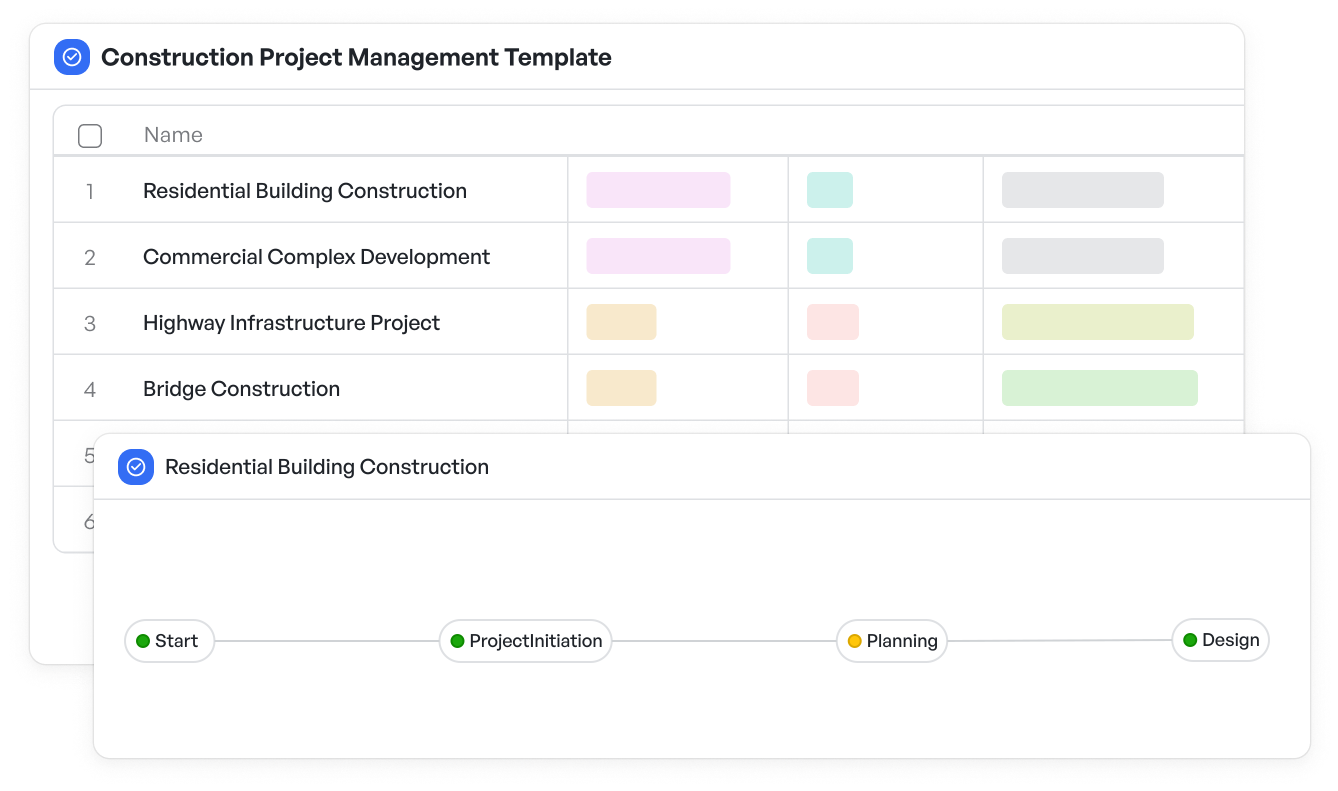How to Implement Crystal In Construction: Improving Project Delivery With Agile Flexibility

Construction projects often face challenges such as shifting requirements, complex stakeholder involvement, and tight deadlines. Applying Agile methodologies can offer construction teams a more adaptive, transparent, and collaborative way to manage these complexities.
One Agile approach gaining attention in construction is the crystal methodology, known for its focus on people, communication, and flexible processes tailored to project size and criticality.
This article explores how crystal can be effectively implemented in construction projects to improve clarity, team collaboration, and project outcomes, along with practical tips on using workflow visualization and templates tailored for this industry.
What Is Crystal and Why Is It Relevant to Construction?
Crystal is an Agile project management methodology that emphasizes flexibility, communication, and the adaptation of processes to fit the specific needs of a project. Unlike rigid frameworks, crystal encourages teams to assess project priorities and risks, then adjust their workflow accordingly.
In construction, where projects can range from small renovations to large infrastructure builds, this adaptability offers significant benefits.
Some of them are:
- Focus on People: Crystal highlights the importance of communication and collaboration among team members, which is essential in coordinating architects, contractors, suppliers, and clients.
- Tailored Process: The methodology scales depending on project size and criticality, allowing construction teams to avoid unnecessary bureaucracy.
- Incremental Delivery: Crystal supports breaking down projects into manageable phases or milestones, allowing for early feedback and course corrections. This approach of granularity in project management enhances control and flexibility.
How Crystal Methodology Addresses Construction Project Challenges
Construction projects typically struggle with challenges like:
- Unclear requirements and scope changes
- Coordination among multiple stakeholders
- Managing timelines and budgets under uncertainty
- Documentation overload or gaps.
Crystal helps mitigate these by emphasizing transparency, continuous communication, and adaptable processes.
By prioritizing the human aspect of project management, crystal facilitates better understanding among team members and stakeholders, reducing misalignment and delays.
Suggested Read:👉Best Project Management Software for Construction
Applying Crystal in Construction: Key Practices and Workflow Tips
Adopting crystal in construction requires thoughtful adjustments to standard practices. Here are five critical steps and best practices for integrating crystal principles into your construction projects:
1. Visualize Workflows Clearly
Use visual workflow tools to map each construction phase, from design to procurement, construction, and handover. Visualization helps everyone understand progress, dependencies, and responsibilities.
 Construction project management template to map project phases, deadlines, and tasks visually
Construction project management template to map project phases, deadlines, and tasks visually2. Define Clear Roles and Communication Channels
Assign specific roles such as project manager, site supervisor, procurement lead, and quality inspector. Maintain regular check-ins and open communication lines to quickly address issues.
3. Implement Incremental Delivery and Feedback
Break the project into milestones (e.g., foundation, framing, finishing). Conduct reviews at each stage to gather feedback and adjust plans before moving forward.
Effective milestone tracking ensures timely progress and helps catch issues early.
4. Customize Documentation Based on Project Size
Avoid overburdening smaller projects with heavy documentation but ensure critical information is recorded and accessible for all team members.
 Construction documentation template keeps key info clear without burdening small projects.
Construction documentation template keeps key info clear without burdening small projects.5. Adapt Planning Based on Risk and Complexity
More complex or high-risk projects may require more detailed planning and tracking, while simpler projects can adopt lighter processes.
Using Construction-Specific Templates to Support Crystal Workflows
Templates designed for construction project management streamline the implementation of crystal by providing pre-built structures for key workflows, schedules, and communication.
Typical templates include:
- Construction Project Management Template: Monitors project phases, deadlines, resource allocation, and task assignments
- Construction Documentation Template: Organizes critical project documents to keep information clear and accessible
- Construction Compliance Checklist Template: Helps maintain adherence to safety standards and regulatory requirements
- Construction Change Order Template: Tracks change requests and project modifications to manage risks efficiently
These templates help maintain clarity and consistency while supporting the flexibility crystal advocates.
Adopting visual workflow platforms with these templates enables construction teams to adapt processes as projects evolve, enhancing collaboration and visibility.
 Construction templates in Meegle
Construction templates in MeegleBenefits of Crystal Methodology for Construction Teams
Construction teams using crystal benefit from:
- Improved Collaboration: By emphasizing people and communication, crystal reduces misunderstandings and fosters teamwork.
- Greater Adaptability: Crystal’s flexibility allows teams to respond swiftly to changing site conditions or client requirements.
- Clear Project Visibility: Visual workflows provide real-time insights into progress, responsibilities, and bottlenecks, enabling teams to monitor projects effectively.
- Efficient Resource Use: Incremental planning helps allocate labor and materials more effectively.
- Reduced Documentation Burden: Tailoring documentation prevents unnecessary overhead while preserving essential records.
These benefits lead to better project control, fewer delays, and higher client satisfaction.
Crystal vs. Traditional Construction Project Management
Traditional construction project management often relies on rigid, linear plans and heavy documentation. While this ensures control, it can slow down projects, especially when unexpected changes occur.
Crystal offers a contrast by encouraging iterative progress, open communication, and process flexibility. It balances the need for structure with adaptability, making it a suitable Agile approach for construction projects where conditions are often unpredictable.
| Aspect | Crystal Methodology | Traditional Construction PM |
|---|---|---|
| Approach | Agile, people-centric, adaptive | Predictive, process-centric, fixed |
| Planning | Iterative, evolving as the project progresses | Fixed upfront planning with detailed Gantt charts |
| Team Structure | Cross-functional, flexible roles | Hierarchical, rigid roles and reporting lines |
| Workflow Flexibility | High – workflows can be adapted based on project size and criticality | Low – predefined workflows that are rarely adjusted |
| Communication Style | Frequent, face-to-face (or virtual) check-ins; informal | Formal, milestone-based reporting |
| Change Management | Embraces change as part of the process | Change is costly and discouraged once planning is complete |
| Documentation | Just enough – varies by team needs | Heavy documentation and sign-offs at every phase |
| Delivery Style | Incremental deliverables and early prototypes for feedback | Single final handoff at project completion |
| Stakeholder Involvement | Continuous engagement and feedback loops | Limited to predefined review and approval checkpoints |
| Risk Management | Risks managed continuously through feedback and iteration | Risks identified and managed mostly at the planning stage |
| Tool Usage | Visual workflows, Kanban boards, lightweight PM tools (e.g., Meegle) | MS Project, Primavera, Excel spreadsheets, formal project dashboards |
| Best Suited For | Projects with uncertain requirements or evolving site conditions | Projects with clear scope, fixed budget, and strict regulatory constraints |
| Speed to Adapt | High – teams can pivot mid-project based on site realities or new inputs | Low – changes require re-approvals, re-planning, and contractual adjustments |
| Examples of Use | Design-build construction, modular construction, complex renovations | Infrastructure builds, public projects, high-compliance industrial construction |
For a deeper understanding of different project management approaches, explore our detailed comparison of Hybrid vs Traditional Project Management.
How to Get Started with Crystal in Construction
If you’re considering crystal for your construction projects, begin by:
- Training your team on Agile principles and the specific practices of crystal.
- Selecting or customizing templates that fit your project size and complexity.
- Introducing visual workflow tools to map out stages and tasks.
- Establishing regular feedback loops with all stakeholders.
- Starting with a pilot project to refine processes before scaling.
| Step | Action | Description |
|---|---|---|
| 1 | Assess Project Type and Team Size | Determine if Crystal is a good fit. It's best for small to mid-sized construction teams with dynamic scopes—such as design-build or renovation projects. |
| 2 | Define Project Criticality | Crystal adapts to project criticality (i.e., potential impact of failure). For high-risk projects, include more controls; for low-risk, leaner processes work well. |
| 3 | Visualize Key Workflows | Map out the key stages—e.g., site prep, foundation, structure, MEP, finishings—using visual tools like whiteboards or Meegle templates to establish clarity. |
| 4 | Set Roles and Communication Cadence | Define who does what (site engineer, architect, PM, contractor). Establish daily stand-ups or weekly check-ins to keep communication tight. |
| 5 | Start with a Pilot Phase | Pick one site or subproject (like HVAC installation or landscaping) to apply Crystal practices. This helps the team build confidence before full-scale adoption. |
| 6 | Emphasize Incremental Delivery | Break down the scope into small, manageable deliverables. For example, finish one floor or wing at a time rather than waiting to hand over the entire building. |
| 7 | Capture Learnings via Retrospectives | After each phase or sprint, review what went well and what didn’t. Adjust tools, workflows, or communication habits based on team feedback. |
| 8 | Use Agile-Ready Tools | Tools like Meegle, Trello, or Notion can help you manage construction sprints, visualize progress, and enable easy collaboration among field and office teams. |
| 9 | Document Only What’s Necessary | Crystal promotes lightweight documentation. Maintain essential records like blueprints, checklists, safety logs, but don’t overburden the team with reports. |
| 10 | Scale Gradually Across Projects | Once the team is comfortable, expand Crystal practices to more areas—like procurement planning, subcontractor scheduling, or inspection workflows. |
Experience Agile Flexibility in Construction with Crystal
Adopting crystal in construction helps teams manage complexity with a people-first approach that values communication, adaptability, and clear workflows. It supports better decision-making, more efficient project delivery, and stronger collaboration among diverse stakeholders.
For construction teams ready to embrace flexible project management without sacrificing control, tools that provide visual workflows and adaptable templates are key.
Simplify construction workflows with Meegle—agile, visual, and built to adapt
The world’s #1 visualized project management tool
Powered by the next gen visual workflow engineRead More
Check All BlogsStart creating impactful work today



